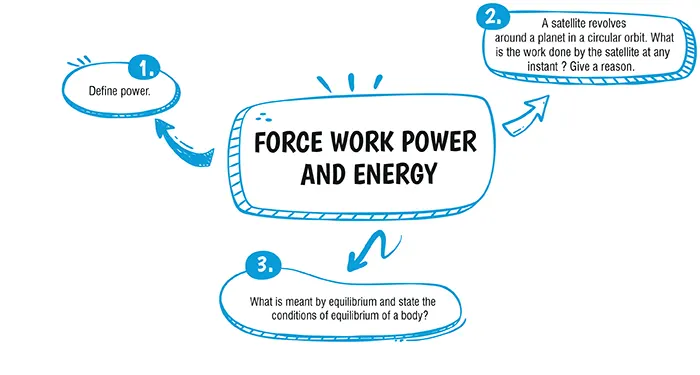Table of Contents

Ans. (a) increases four times
Explanation:
Kinetic energy and momentum mathematical expression is defined is-
\text{K.E } = \dfrac{1}{2} \text{mv}^2 \\[4.5 bp]
\rArr \text{K.E = } \dfrac{1}{2} \text{mv}^2 × \dfrac{m}{m} = \dfrac{(mv)^2}{2m} \\[4.5 bp]
\rArr \text{K.E = } \dfrac{P^2}{2m} \text{(∵ Momentum,P = mv)}\\[4.5 bp]
\rArr P = \sqrt{2m(k. E.)}\\
Now, new kinetic energy. K.E’=16 K.E.
\\\text{New, linear momentum, P = }\sqrt{2m(k.E.)} = \sqrt{2m(16 k.E.)} \\[4.5 bp]
\rArr P = 4 \sqrt{2m(k.E.)}\\[4.5 bp]
\rArr P = 4 P [\because P = \sqrt{2m(k.E.)}]
Ans. (a) 25 cm
Explanation:
Given, uniform meter rule, so weight (Mg) will act at 25 cm. Mg produces anticlockwise moment about point o
Explanation:
(i) Power is the rate at which work is done or energy is transferred or converted. In physics, it is typically measured in watts (W) and is the amount of energy or work done per unit of time. Mathematically, power (P) is defined as:
P = W / t
Where:
P = Power (in watts, W)
W = Work done or energy transferred (in joules, J)
t = Time (in seconds, s)
(ii) Power is a scalar quantity. This means that it has magnitude but no direction. Unlike vector quantities, which have both magnitude and direction (such as force or velocity), power is only concerned with how much energy is transferred or work is done per unit of time, without specifying a particular direction.
Explanation:
The work done by a satellite in a circular orbit around a planet is equal to zero. This is because work is defined as the product of the force applied and the displacement over which the force is applied, and the displacement for an object moving in a circular orbit is always perpendicular to the force acting on it.
In the case of a satellite in a circular orbit, the gravitational force between the satellite and the planet provides the centripetal force required to keep the satellite in its circular path. The centripetal force always acts perpendicular to the direction of motion, which means that the displacement of the satellite is also perpendicular to the force.
Work done (W) is calculated using the formula:
W = F * d * cos(θ)
Where:
W is the work done
F is the force applied
d is the displacement
θ is the angle between the force and the direction of motion.
Since θ is 90 degrees (perpendicular), the cosine of 90 degrees is 0, which means that the work done in a circular orbit is zero. Therefore, the satellite does no work on itself as it revolves in a circular orbit around the planet, and the work done by the satellite is also zero.
Explanation:
When a number of forces acting on a body produce no change in its state of rest or of uniform motion, the body is said to be in equilibrium.
The two conditions of equilibrium of a body:
(i) The resultant of all the forces acting on the body should be equal to zero.
(ii) The algebraic sum of moments of all the forces acting on the body about a point should be zero.
Download Mind Map of this chapter
Download NowWant to Practice Mock Tests of this chapter
Practice NowDownload Important Questions of this chapter
Download Now| Chapter No. | Chapter Name |
|---|---|
| Chapter 1 | Force Work Power and Energy |
| Chapter 2 | Simple Machines |
| Chapter 3 | Refraction of Light |
| Chapter 4 | Refraction Through Lenses |
| Chapter 5 | Spectrum |
| Chapter 6 | Sound |
| Chapter 7 | Electricity |
| Chapter 8 | Electrical Power and Household Circuits |
| Chapter 11 | Magnetic Effect of Current |
| Chapter 12 | Specific Heat Capacity and Latent Heat |
| Chapter 13 | Radioactivity and Nuclear Energy |
| Chapter Wise Important Questions for ICSE Board Class 10 Physics |
|---|
| Force Work Power and Energy |
| Simple Machines |
| Refraction of Light |
| Refraction Through Lenses |
| Spectrum |
| Sound |
| Electricity |
| Electrical Power and Household Circuits |
| Magnetic Effect of Current |
| Specific Heat Capacity and Latent Heat |
| Radioactivity and Nuclear Energy |
CBSE Important Questions Class 10
ICSE Important Questions Class 10
CBSE Important Questions Class 10
ICSE Important Questions Class 10